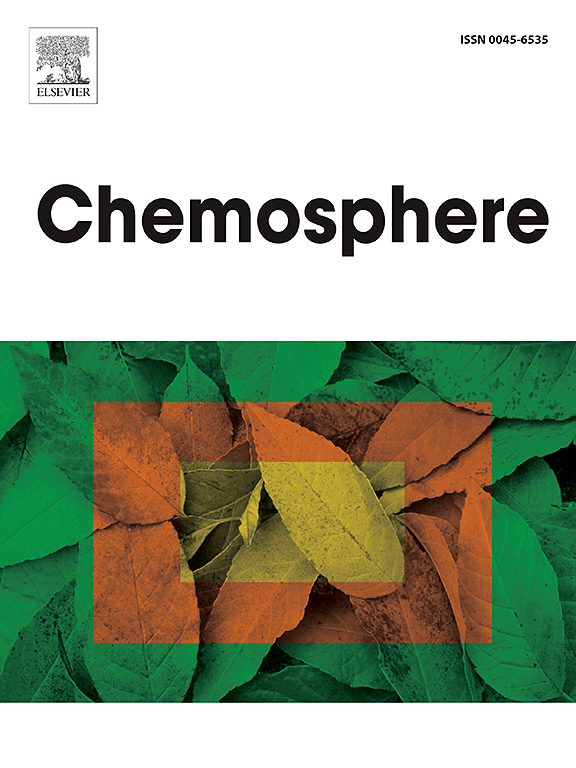生物炭减轻纳米塑料和双酚A介导的斑点鲶鱼免疫、神经和肠道微生物毒性
IF 8.1
2区 环境科学与生态学
Q1 ENVIRONMENTAL SCIENCES
引用次数: 0
摘要
纳米塑料(NPs)和双酚A (BPA)具有丰富的工业用途,它们大量生产并无处不在地释放到环境中,对生态和人类健康构成严重威胁。生物炭因其减轻污染物对植物的负面影响的能力而被广泛研究。因此,本研究旨在探讨生物炭与聚苯乙烯纳米塑料(PS-NPs,尺寸为80 nm)和双酚a共暴露是否能减轻其对斑点伊talurus的毒性影响,并维持其正常生长。分别暴露于PS-NPs (0.5 mg/L)和BPA (0.2 mg/L)中,并与PS-NPs +生物炭和BPA +生物炭共暴露7 d。结果表明,PS-NPs和BPA单次暴露可引起肝细胞肿胀、肠绒毛扩散等组织损伤,并诱导氧化应激。PS-NPs和BPA单独暴露导致与免疫系统相关的生物标志物的酶活性和遗传表达发生显著变化,产生炎症反应。它还导致神经递质酶(ACH、ChAT、AChE)的失调和神经元基因的过度表达,导致神经毒性。此外,肠道菌群的多样性增加和组成改变(Plesiomonas, Pseudomonas),导致肠道菌群失调。然而,生物炭的存在(0.5 g/L)减少了PS-NPs和BPA在鱼类体内的积累,并在不同程度上缓解了PS-NPs和BPA的毒性影响。总体而言,生物炭有助于减轻PS-NPs和BPA对氧化应激、组织病理学、免疫系统、神经反应和肠道微生物群的负面影响。本研究强调了生物炭在减轻NPs和BPA对水生生物的负面影响方面的潜力。本文章由计算机程序翻译,如有差异,请以英文原文为准。

Biochar alleviates nanoplastics and bisphenol A mediated immunological, neurological and gut microbial toxicity in channel catfish Ictalurus punctatus
Nanoplastics (NPs) and bisphenol A (BPA), exhibit abundant industrial applications, are produced in large volumes and ubiquitously released into the environment, posing a serious threat to ecological and human health. Biochar has been extensively studied for its ability to mitigate the negative effects of contaminants on plants. Therefore, this study aims to investigate whether biochar co-exposure with polystyrene nanoplastics (PS-NPs, size 80 nm) and BPA mitigate their toxic impacts on Ictalurus punctatus and maintain its normal growth. The I. punctatus was exposed individually to PS-NPs (0.5 mg/L) and BPA (0.2 mg/L) as well as co-exposed to PS-NPs + biochar and BPA + biochar for 7 days. Results showed PS-NPs and BPA single exposure caused tissue damage in terms of hepatocyte swelling and gut villi diffusion, and induced oxidative stress. PS-NPs and BPA single exposures led to significant changes in enzymatic activities and genetic expressions of biomarkers related to the immune system, producing inflammatory response. It also led to dysregulation of neurotransmitter enzymes (ACH, ChAT, AChE) and overexpression of neuron genes, resulting in neurotoxicity. Moreover, there was an increase in the diversity and alteration in composition of the gut microbiota (Plesiomonas, Pseudomonas), resulting in dysbiosis of the gut microbiota. However, biochar presence (0.5 g/L) reduced the accumulation of PS-NPs and BPA in fish and contributed to various degrees of mitigation for the toxic impacts of PS-NPs and BPA. Overall, biochar helped to mitigate the negative effects of PS-NPs and BPA on oxidative stress, histopathology, immune system, neurological responses and gut microbiota. This study emphasized the potential of biochar to mitigate the negative impacts of NPs and BPA on aquatic organisms.
求助全文
通过发布文献求助,成功后即可免费获取论文全文。
去求助
来源期刊

Chemosphere
环境科学-环境科学
CiteScore
15.80
自引率
8.00%
发文量
4975
审稿时长
3.4 months
期刊介绍:
Chemosphere, being an international multidisciplinary journal, is dedicated to publishing original communications and review articles on chemicals in the environment. The scope covers a wide range of topics, including the identification, quantification, behavior, fate, toxicology, treatment, and remediation of chemicals in the bio-, hydro-, litho-, and atmosphere, ensuring the broad dissemination of research in this field.
 求助内容:
求助内容: 应助结果提醒方式:
应助结果提醒方式:


